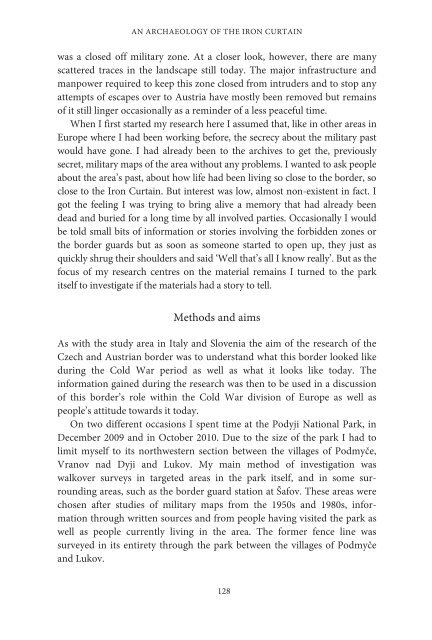1JZGauQ
1JZGauQ
1JZGauQ
Create successful ePaper yourself
Turn your PDF publications into a flip-book with our unique Google optimized e-Paper software.
AN ARCHAEOLOGY OF THE IRON CURTAIN<br />
was a closed off military zone. At a closer look, however, there are many<br />
scattered traces in the landscape still today. The major infrastructure and<br />
manpower required to keep this zone closed from intruders and to stop any<br />
attempts of escapes over to Austria have mostly been removed but remains<br />
of it still linger occasionally as a reminder of a less peaceful time.<br />
When I first started my research here I assumed that, like in other areas in<br />
Europe where I had been working before, the secrecy about the military past<br />
would have gone. I had already been to the archives to get the, previously<br />
secret, military maps of the area without any problems. I wanted to ask people<br />
about the area’s past, about how life had been living so close to the border, so<br />
close to the Iron Curtain. But interest was low, almost non-existent in fact. I<br />
got the feeling I was trying to bring alive a memory that had already been<br />
dead and buried for a long time by all involved parties. Occasionally I would<br />
be told small bits of information or stories involving the forbidden zones or<br />
the border guards but as soon as someone started to open up, they just as<br />
quickly shrug their shoulders and said ‘Well that’s all I know really’. But as the<br />
focus of my research centres on the material remains I turned to the park<br />
itself to investigate if the materials had a story to tell.<br />
Methods and aims<br />
As with the study area in Italy and Slovenia the aim of the research of the<br />
Czech and Austrian border was to understand what this border looked like<br />
during the Cold War period as well as what it looks like today. The<br />
information gained during the research was then to be used in a discussion<br />
of this border’s role within the Cold War division of Europe as well as<br />
people’s attitude towards it today.<br />
On two different occasions I spent time at the Podyji National Park, in<br />
December 2009 and in October 2010. Due to the size of the park I had to<br />
limit myself to its northwestern section between the villages of Podmyče,<br />
Vranov nad Dyji and Lukov. My main method of investigation was<br />
walkover surveys in targeted areas in the park itself, and in some surrounding<br />
areas, such as the border guard station at Šafov. These areas were<br />
chosen after studies of military maps from the 1950s and 1980s, information<br />
through written sources and from people having visited the park as<br />
well as people currently living in the area. The former fence line was<br />
surveyed in its entirety through the park between the villages of Podmyče<br />
and Lukov.<br />
128




